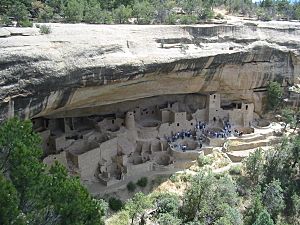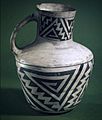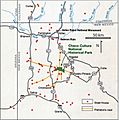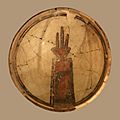Ancestral Puebloans facts for kids

The Ancestral Puebloans were an old Native American culture. They lived in what is now the southwestern United States. Their homes were in areas that are now Colorado, Utah, Arizona, and New Mexico. Their culture ended around 1600 AD. The Navajos called them the Anasazi.
These people left behind many important places. Two of these places are now UNESCO World Heritage Sites. Archaeologists have found things that show the Ancestral Puebloans were skilled. They knew how to make pottery and how to do weaving. They also used irrigation to water their crops. They even drew special symbols.
Images for kids
-
White House Ruins, Canyon de Chelly National Monument
-
Horseshoe Tower in the snow, Hovenweep National Monument
-
Pueblo Bonito, the largest of the Chacoan Great Houses, stands at the foot of Chaco Canyon's northern rim.
-
Multistory dwellings at Bandelier: Rock wall foundations and beam holes and "cavates" carved into volcanic tuff remain from upper floors.
-
Mancos Pitcher with Black on White Geometric Designs, Ancestral Pueblo, 900–1300 CE, Brooklyn Museum
-
Casa Rinconada, Chaco Culture National Historical Park, New Mexico
-
Precontact roads and great houses in the San Juan Basin
-
Plan of entire Spruce Tree House from above, cut from laser scan data collected by a CyArk/National Park Service partnership
-
Section view of Kiva A in Mesa Verde's Fire Temple, cut from laser scan data collected by a CyArk/National Park Service partnership. Since Fire Temple was at least partially built to conform to the dimensions of its cliff alcove, it is neither round in form nor truly subterranean like other structures defined as kivas.
-
Chaco Culture bowl, 11th to 13th centuries, Pueblo Alto, Chaco Canyon
-
Ancestral Puebloan ruins in Dark Canyon Wilderness, Utah
-
Pecos Glazeware bowl, Pecos National Historical Park
-
Boy in doorway, Balcony House, Mesa Verde National Park
See also
 In Spanish: Anasazi para niños
In Spanish: Anasazi para niños



















